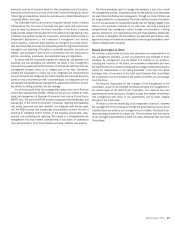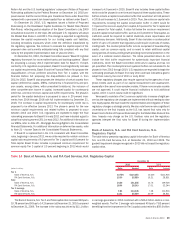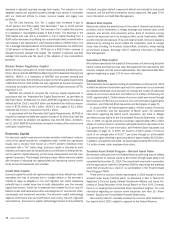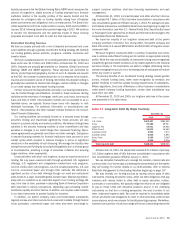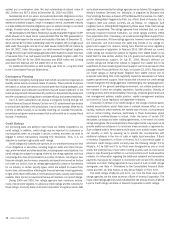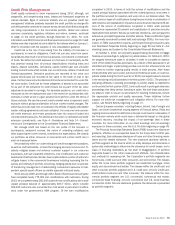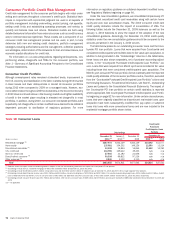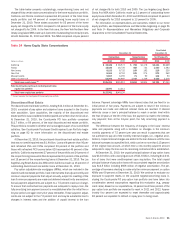Bank of America 2010 Annual Report Download - page 75
Download and view the complete annual report
Please find page 75 of the 2010 Bank of America annual report below. You can navigate through the pages in the report by either clicking on the pages listed below, or by using the keyword search tool below to find specific information within the annual report.
liquidity measure is the Net Stable Funding Ratio (NSFR) which measures the
amount of longer-term, stable sources of funding employed by a financial
institution relative to the liquidity profiles of the assets funded and the
potential for contingent calls on funding liquidity arising from off-balance
sheet commitments and obligations over a one-year period. The Basel Com-
mittee expects the LCR to be implemented in January 2015 and the NSFR in
January 2018, following observation periods beginning in 2012. We continue
to monitor the development and the potential impact of these evolving
proposals and expect to be able to meet the final requirements.
Diversified Funding Sources
We fund our assets primarily with a mix of deposits and secured and unse-
cured liabilities through a globally coordinated funding strategy. We diversify
our funding globally across products, programs, markets, currencies and
investor bases.
We fund a substantial portion of our lending activities through our deposit
base which was $1.0 trillion and $992 billion at December 31, 2010 and
2009. Deposits are primarily generated by our Deposits, Global Commercial
Banking, GWIM and GBAM segments. These deposits are diversified by
clients, product type and geography. Certain of our U.S. deposits are insured
by the FDIC. We consider a substantial portion of our deposits to be a stable,
low-cost and consistent source of funding. We believe this deposit funding is
generally less sensitive to interest rate changes, market volatility or changes
in our credit ratings than wholesale funding sources.
Certain consumer lending activities, primarily in our banking subsidiaries,
may be funded through securitizations. Included in these consumer lending
activities are the extension of mortgage, credit card, auto loans, home equity
loans and lines of credit. If securitization markets are not available to us on
favorable terms, we typically finance these loans with deposits or with
wholesale borrowings. For additional information on securitizations, see
Note 8 – Securitizations and Other Variable Interest Entities to the Consoli-
dated Financial Statements.
Our trading activities are primarily funded on a secured basis through
securities lending and repurchase agreements; these amounts will vary
based on customer activity and market conditions. We believe funding these
activities in the secured financing markets is more cost-efficient and less
sensitive to changes in our credit ratings than unsecured financing. Repur-
chase agreements are generally short-term and often overnight. Disruptions
in secured financing markets for financial institutions have occurred in prior
market cycles which resulted in adverse changes in terms or significant
reductions in the availability of such financing. We manage the liquidity risks
arising from secured funding by sourcing funding globally from a diverse group
of counterparties, providing a range of securities collateral and pursuing
longer durations, when appropriate.
Unsecured debt, both short- and long-term, is also an important source of
funding. We may issue unsecured debt through syndicated U.S. registered
offerings, U.S. registered and unregistered medium-term note programs,
non-U.S. medium-term note programs, non-U.S. private placements, U.S. and
non-U.S. commercial paper and through other methods. We distribute a
significant portion of our debt offerings through our retail and institutional
sales forces to a large, diversified global investor base. Maintaining relation-
ships with our investors is an important aspect of our funding strategy. We
may, from time to time, purchase outstanding Bank of America Corporation
debt securities in various transactions, depending upon prevailing market
conditions, liquidity and other factors. In addition, we may also make markets
in our debt instruments to provide liquidity for investors.
In addition, our parent company, bank and broker-dealer subsidiaries
regularly access short-term secured and unsecured markets through federal
funds purchased, commercial paper and other short-term borrowings to
support customer activities, short-term financing requirements and cash
management.
At December 31, 2010, commercial paper and other short-term borrow-
ings included $6.7 billion of VIEs that were consolidated in accordance with
new consolidation guidance effective January 1, 2010. For average and year-
end balance discussions, see Balance Sheet Overview beginning on page 33.
For more information, see Note 12 –Federal Funds Sold, Securities Borrowed
or Purchased Under Agreements to Resell and Short-term Borrowings to the
Consolidated Financial Statements.
We issue the majority of our long-term unsecured debt at the parent
company and Bank of America, N.A. During 2010, the parent company and
Bank of America, N.A. issued $28.8 billion and $3.5 billion of long-term senior
unsecured debt.
We issue long-term unsecured debt in a variety of maturities and curren-
cies to achieve cost-efficient funding and to maintain an appropriate maturity
profile. While the cost and availability of unsecured funding may be negatively
impacted by general market conditions or by matters specific to the financial
services industry or the Corporation, we seek to mitigate refinancing risk by
actively managing the amount of our borrowings that we anticipate will mature
within any month or quarter.
The primary benefits of our centralized funding strategy include greater
control, reduced funding costs, wider name recognition by investors and
greater flexibility to meet the variable funding requirements of subsidiaries.
Where regulations, time zone differences or other business considerations
make parent company funding impractical, certain other subsidiaries may
issue their own debt.
At December 31, 2010 and 2009, our long-term debt was in the curren-
cies presented in the table below.
Table 17 Long-term Debt By Major Currency
(Dollars in millions)
2010 2009
December 31
U.S. Dollar
$302,487
$281,692
Euros
87,482
99,917
Japanese Yen
19,901
19,903
British Pound
16,505
16,460
Australian Dollar
6,924
7,973
Canadian Dollar
6,628
4,894
Swiss Franc
3,069
2,666
Other
5,435
5,016
Total long-term debt
$448,431
$438,521
At December 31, 2010, the above table includes $71.0 billion of primarily
U.S. Dollar long-term debt of VIEs that were consolidated in accordance with
new consolidation guidance effective January 1, 2010.
We use derivative transactions to manage the duration, interest rate and
currency risks of our borrowings, considering the characteristics of the assets
they are funding. For further details on our ALM activities, refer to Interest
Rate Risk Management for Nontrading Activities beginning on page 107.
We also diversify our funding sources by issuing various types of debt
instruments including structured notes, which are debt obligations that pay
investors with returns linked to other debt or equity securities, indices,
currencies or commodities. We typically hedge the returns we are obligated
to pay on these notes with derivative positions and/or in the underlying
instruments so that from a funding perspective, the cost is similar to our
other unsecured long-term debt. We could be required to immediately settle
certain structured note obligations for cash or other securities under certain
circumstances, which we consider for liquidity planning purposes. We believe,
however, that a portion of such borrowings will remain outstanding beyond the
Bank of America 2010 73




